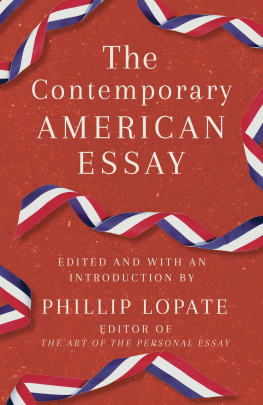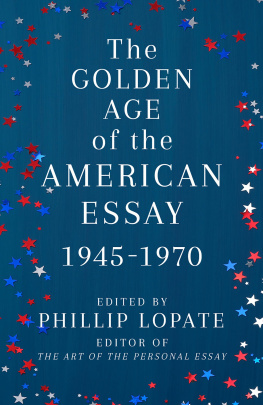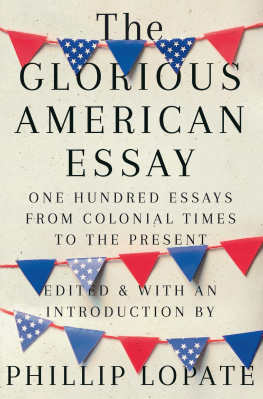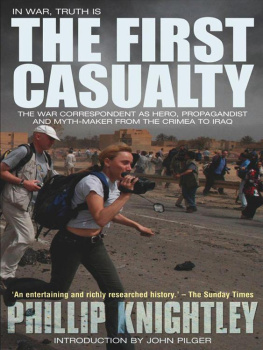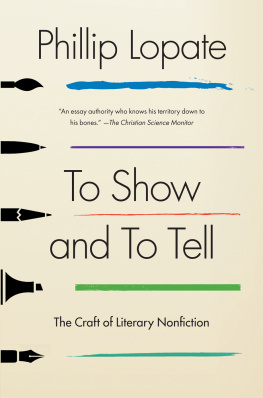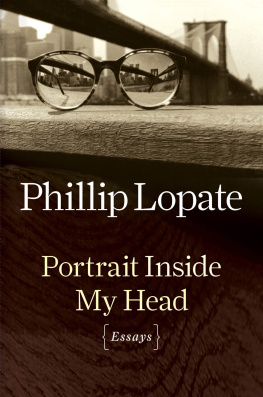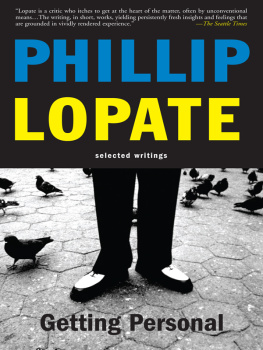Phillip Lopate - Contemporary American Essay
Here you can read online Phillip Lopate - Contemporary American Essay full text of the book (entire story) in english for free. Download pdf and epub, get meaning, cover and reviews about this ebook. year: 2021, publisher: Knopf Doubleday Publishing Group, genre: Detective and thriller. Description of the work, (preface) as well as reviews are available. Best literature library LitArk.com created for fans of good reading and offers a wide selection of genres:
Romance novel
Science fiction
Adventure
Detective
Science
History
Home and family
Prose
Art
Politics
Computer
Non-fiction
Religion
Business
Children
Humor
Choose a favorite category and find really read worthwhile books. Enjoy immersion in the world of imagination, feel the emotions of the characters or learn something new for yourself, make an fascinating discovery.
- Book:Contemporary American Essay
- Author:
- Publisher:Knopf Doubleday Publishing Group
- Genre:
- Year:2021
- Rating:4 / 5
- Favourites:Add to favourites
- Your mark:
- 80
- 1
- 2
- 3
- 4
- 5
Contemporary American Essay: summary, description and annotation
We offer to read an annotation, description, summary or preface (depends on what the author of the book "Contemporary American Essay" wrote himself). If you haven't found the necessary information about the book — write in the comments, we will try to find it.
Contemporary American Essay — read online for free the complete book (whole text) full work
Below is the text of the book, divided by pages. System saving the place of the last page read, allows you to conveniently read the book "Contemporary American Essay" online for free, without having to search again every time where you left off. Put a bookmark, and you can go to the page where you finished reading at any time.
Font size:
Interval:
Bookmark:
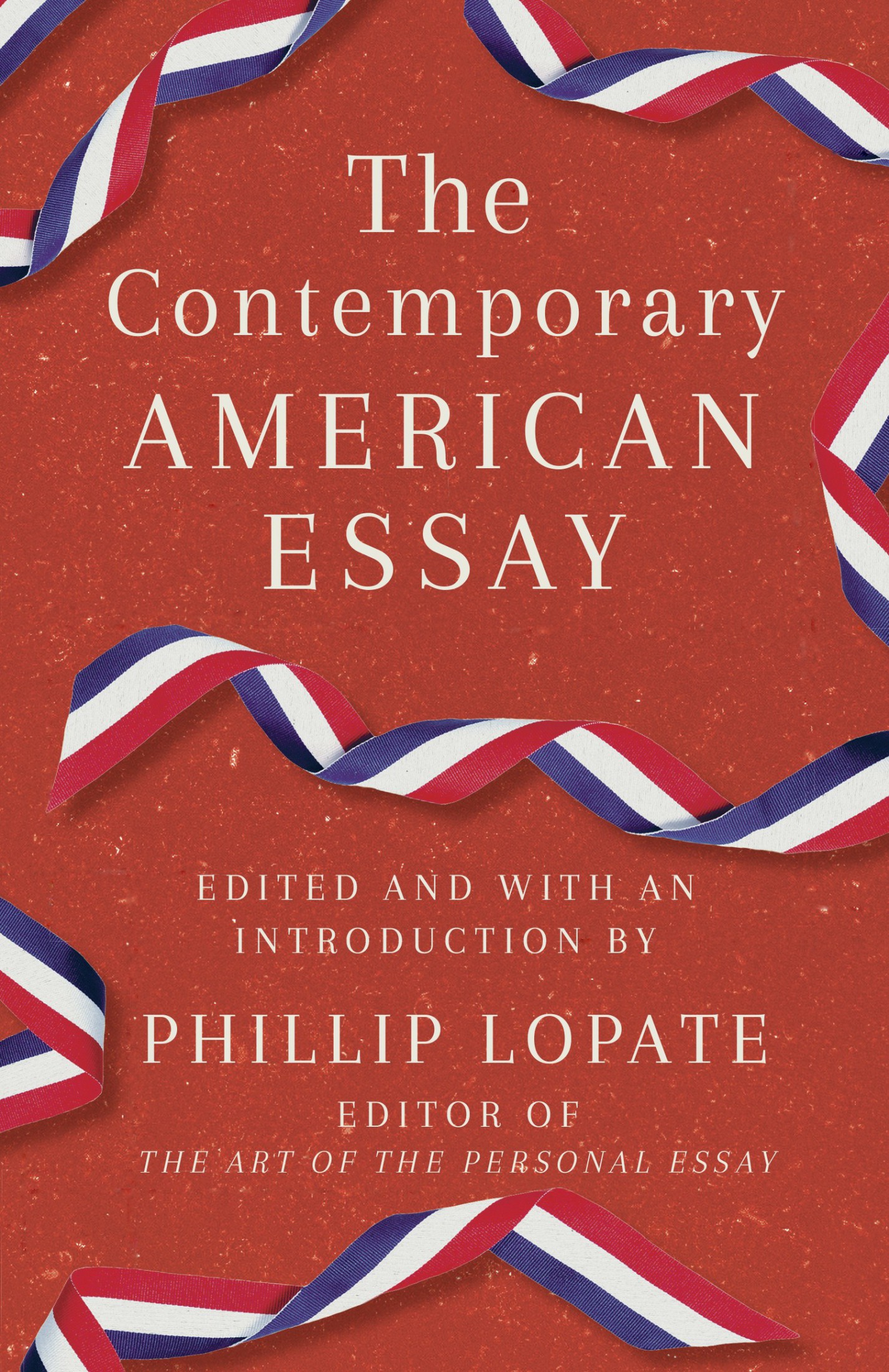
Phillip Lopate is the author of To Show and to Tell: The Craft of Literary Nonfiction and four essay collections: Bachelorhood, Against Joie de Vivre, Portrait of My Body, and Portrait Inside My Head. He is the editor of the anthologies The Glorious American Essay,The Golden Age of the American Essay, The Art of the Personal Essay, Writing New York, and American Movie Critics. He was awarded a John Simon Guggenheim Fellowship, a Cullman Center Fellowship, two National Endowment for the Arts grants, and two New York Foundation for the Arts grants. He is a professor of writing at Columbia Universitys nonfiction MFA program and lives in Brooklyn, New York.
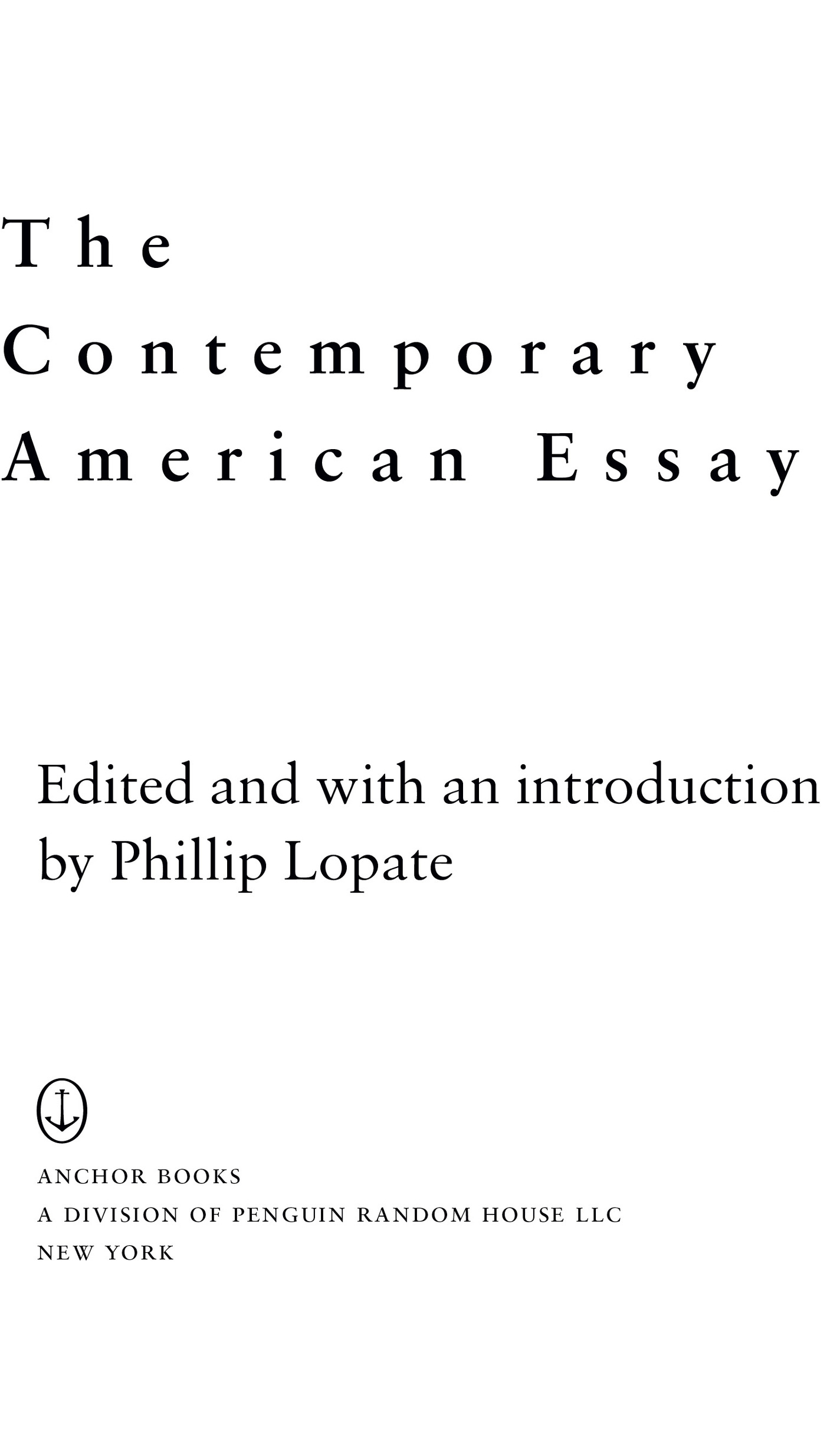
AN ANCHOR BOOKS ORIGINAL, AUGUST 2021
Introduction and compilation copyright 2021 by Phillip Lopate
All rights reserved. Published in the United States by Anchor Books, a division of Penguin Random House LLC, New York, and distributed in Canada by Penguin Random House Canada Limited, Toronto.
Anchor Books and colophon are registered trademarks of Penguin Random House LLC.
constitute an extension of this copyright page.
The Cataloging-in-Publication Data is on file at the Library of Congress.
Anchor Books Trade Paperback ISBN9780525567325
Ebook ISBN9780593314975
Cover design by Sarahmay Wilkinson
Cover photograph Vonkara1/iStock/Getty Images
www.anchorbooks.com
ep_prh_5.7.1_c0_r0
The first quarter of the twenty-first century has been an uneasy time of rupture and anxiety, filled with historic challenges and opportunities. In that close to twenty-five-year span, the United States witnessed the ominous opening shot of September 11, followed by the seemingly unending Afghanistan and Iraq wars, the effort to control HIV/AIDS, the 2008 recession, the election of the first African American president, the legalization of same-sex marriage, the contentious reign of Donald Trump, the stepped-up restriction of immigrants, the #MeToo movement, Black Lives Matter, and the coronavirus pandemic, just to name a few major events. Intriguingly, the essay has blossomed during this time, in what many would deem an exceptionally good period for literary nonfictionif not a golden one, then at least a silver: I think we can agree that there has been a remarkable outpouring of new and older voices responding to this perplexing moment in a form uniquely amenable to the processing of uncertainty.
When the century began, essays were considered box office poison; editors would sometimes disguise collections of the stuff by packaging them as theme-driven memoirs. All that has changed: a generation of younger readers has embraced the essay form and made their favorite authors into bestsellers. We could speculate on the reasons for this growing popularitythe hunger for humane, authentic voices trying to get at least a partial grip on the truth in the face of so much political mendacity and information overload; the convenient, bite-size nature of essays that require no excessive time commitment; the rise of identity politics and its promotion of eloquent spokespersons. Rather than trying to figure out why its happening, whats important is to chart the high points of this resurgence, and to account for the range of styles, subgenres, experimental approaches, and moral positions that characterize the contemporary American essay.
Of course, roping off a period like the year 2000 to the present and calling it contemporary is somewhat arbitrary, but one has to start somewhere. At least this artificial chronological box allows for the inclusion of older authors who made their mark in the twentieth century and had the temerity to keep producing significant work in the twenty-first (such as John McPhee, Joyce Carol Oates, Barry Lopez, Thomas Lynch). Just as set designers of period films make a mistake in choosing only articles of clothing or furnishings that were produced in that era, forgetting that we always live with the layered material objects of previous decades, so it would be wrong to restrict the literary flavor of an era to writers under forty. Indeed, what makes this period so interesting is the mlange of clashing generations and points of view. There are still tightly reasoned sequential essays being written in the classical mode, side by side with ones that resist that tidiness.
The essay has always been an adaptable, plastic, shape-shifting form: it may take the form of meditation, reportage, blog, humor piece, eulogy, autobiographical slice, diatribe, list, collage, mosaic, lecture, or letter. Contemporary practitioners seem bent on further testing its limits. For instance, Lia Purpura, Eula Biss, and Mary Cappello are drawn to the lyric essay, which stresses the essays associational rather than narrative or argumentative properties. Cappello has shrewdly spoken about essay writingthat nongenre that allows for untoward movement, apposition, and assemblage, that is one part conundrum, one part accident, and that fosters a taste for discontinuity. In line with modernist aesthetics, a mosaic essay with a taste for discontinuity may be constructed from fragments, numbered or not, with white space breaks between pieces that connect intuitively or emotionally if not logically. It is up to the reader to figure it out. The list essay, which is highly generative of disparate materials, by its very nature evades an argumentative through line, and can seem initially as random as a poetic inventory by Whitman, though it may deepen subtly and organically. (For example, Nicholson Bakers charming One Summer, which crisscrosses periods of his life, nevertheless builds to a revealing self-portrait.)
While the influence of poetic technique on the lyric essay has been largely acknowledged, less recognized is the short storys impact on the contemporary essay. Many memoir essays exist in a kind of fictive space, progressing through scene and dialogue and a sensory-laden mood that stays tied to the moment by moment. The piece itself may be entirely factual, but the sentences give off a minimalist frisson that shows the influence of short story writers such as Lydia Davis, Amy Hempel, and Lorrie Moore.
Nonfiction has been agitated in recent years by certain ethical questions, such as, How legitimate is it to insert fictional details in nonfiction? or Is it proper to appropriate the voice of someone of a different ethnicity, sex, or social class? That both can be done successfully can be seen in Hilton Alss I Am the Happiness of This World, which channels the silent film star Louise Brookss ruminations, as though Brooks herself were dictating an essay to Als from the grave.
The role of technologythe Internet and social mediain altering our rhetorical lives may even affect the typography of an essay (as evidenced in Ander Monsons unshackled Failure: A Meditation). Are we merging with our computers and turning into spiritual machines? wondered the essayist Meghan OGieblyn. The blog, once viewed as a debasement or poor relation of the essay, has proven itself a useful invitation to free-flowing, self-surprising displays of consciousness (see Ross Gay, Eileen Myles). Some feminist essayists have expressed a desire to arrive at a post-patriarchal essay, implying that the very structure of linear argumentation is authoritarian and reinforces status quo sexist power relations. (Maggie Nelsons influential
Font size:
Interval:
Bookmark:
Similar books «Contemporary American Essay»
Look at similar books to Contemporary American Essay. We have selected literature similar in name and meaning in the hope of providing readers with more options to find new, interesting, not yet read works.
Discussion, reviews of the book Contemporary American Essay and just readers' own opinions. Leave your comments, write what you think about the work, its meaning or the main characters. Specify what exactly you liked and what you didn't like, and why you think so.

